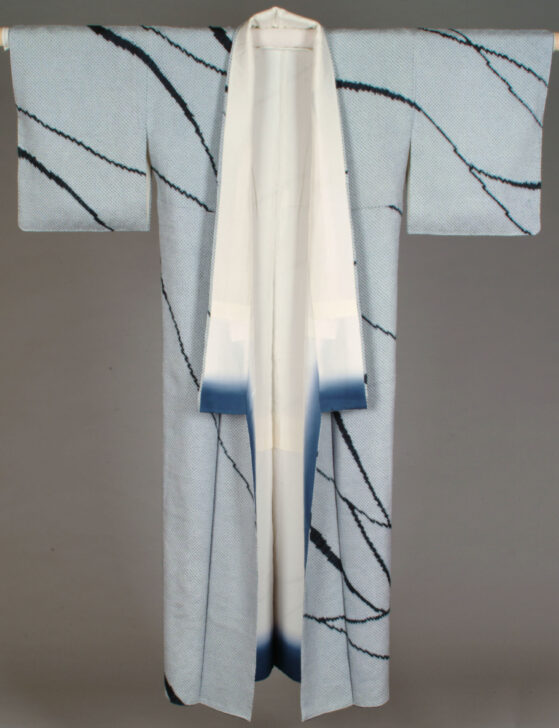Gray kimono with overall shibori indigo dot pattern and random dark blue lines
Japanese

Description
This adzuki-bean colored kimono with a grand scene of a Heian period (794–1185) aristocratic residence is an example of formal wear for a middle-aged woman. Called hômongi (visiting wear), this type is appropriate for occasions such as New Year’s Day celebrations or the wedding of a niece or nephew. In the language of kimono, the placement of motifs denotes the degree of formality. In hômongi the asymmetrical patterning wraps without interruption from the front across the side seams to the back hem. The only other motif (in this kimono, a delicate willow tree) appears below the side of one shoulder. Hômongi motifs are often drawn from the classics and refer to Heian court culture. The elegant scene on this kimono is based on the Tale of Genji, the popular story of the amorous prince Hikaru Genji. The empty cart suggests that he is visiting one of his lovers’ residences.
The luminous gold and silver brocade obi would have been worn with the most formal kimono, such as black tomesode. This type of obi (called maruobi) consists of four meters of solid brocade cloth fifty centimeters wide; maruobi are so heavy that in the contemporary era they have become almost obsolete. In the twentieth century, the demand for lighter, more comfortable obi prompted the invention of the modified obi seen elsewhere in the exhibition.
(Wrapped in Silk & Gold Exhibition, Summer 2010)
Subject Matter:
This kimono required a labor intensive technique called shibori, in which hundreds of hours would have been spent tying up each small section where white can be seen on the fabric before immersing it in dye. Shibori textiles are very expensive due to the time and skill required to produce them.
Physical Description:
Gray silk with indigo tie-dye hitta mura pattern cut across with diagonal wavy lines of dark blue. Lining is plain-weave white silk with blue bokashi at sleeve ends and hem.
Usage Rights:
If you are interested in using an image for a publication, please visit https://umma.umich.edu/request-image/ for more information and to fill out the online Image Rights and Reproductions Request Form.